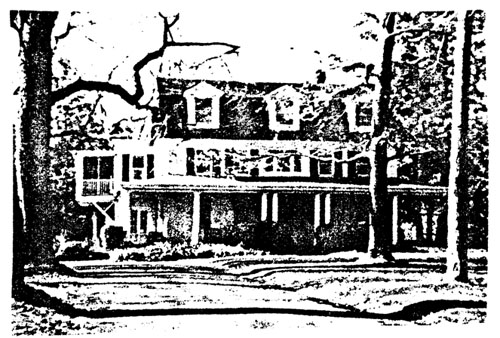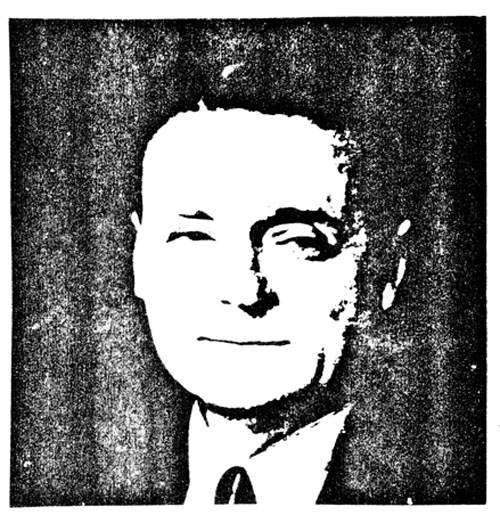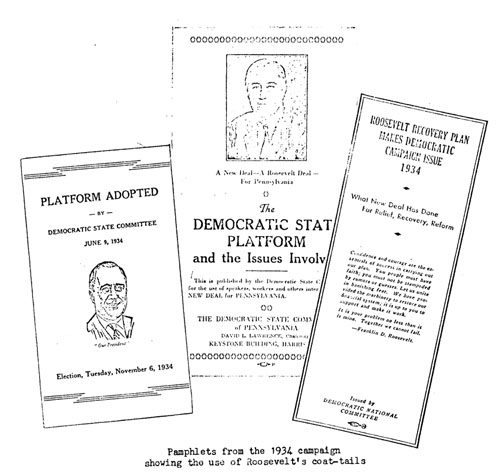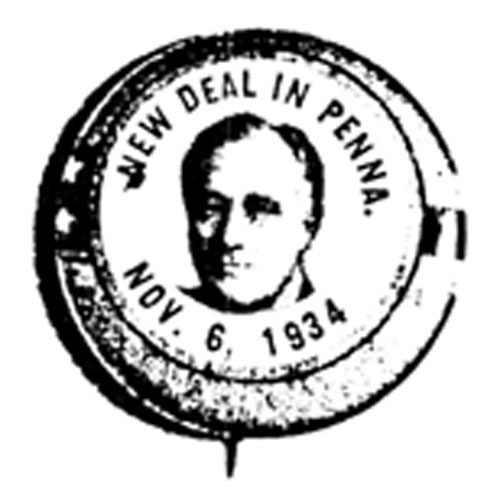|
Home : Quarterly Archives : Volume 20 |
Tredyffrin Easttown Historical Society |
|
Source: October 1982 Volume 20 Number 4, Pages 135–140 When A Native of Devon was Elected Governor It had been forty-four years since a Democrat had been elected to be the governor of Pennsylvania. In the previous ten elections the voters had elected a Republican to the office. But in 1934 many of the state's Democratic party leaders considered the outlook materially brighter for their party. As a result of their early support of Franklin D. Roosevelt in his contest with Al Smith for the presidential nomination in 1932, they now had control of the federal patronage in the state. There was also a feeling that the general popularity of President Roosevelt and his New Deal program throughout the country might well be reflected in the vote in Pennsylvania, even though the Keystone State had been one of the six states to support Herbert Hoover in the 1932 election. With a dozen or so Democrats being discussed as possible gubernatorial candidates, early in the year several of the party chieftans met in Philadelphia to pick their candidate. Among those at the meeting were the long-time state party leader Joseph Guffey, publisher David Stern, contractors Matthew McCoskey and John B. Kelly, and David Lawrence. On the first of February they announced their choice for the nomination: it was George H. Earle 3d, a New Deal Democrat. Earle was born in Devon, on December 5, 1890. His birth date, coincidental!y, was almost exactly a month after the last previous Democrat governor was elected. Earle' s birthplace is a stone house on the west side of Waterloo Road, just north of the intersection of it and Chester Road. It is said to be one of the four oldest houses in Devon.
Earle's birthplace It was allegedly built in the early part of the eighteenth century, though it was remodeled by the Earles in the mid-1880's. As soon as the remodeling was completed, George H. Earle Jr., a Philadelphia lawyer, banker, and manufacturer, and his wife moved into their new home on a 25-acre farm. (A barn on the farm is still standing near the house.) It has been suggested that the Devon location had been recommended to Earle by one of his friends, Thomas Mellon Rogers, who also lived in Devon. Rogers was the architect in charge of the restoration of Independence Hall at that time; a spiral staircase installed in the house while the Earles lived there is said originally to have been the stairway to the old State House belfry. The Earles lived in Devon until 1899. In that year they moved to a larger farm of 1000 acres, which they had always wanted, and sold their Devon home. During the time they lived in Devon, the early schooling of the future governor was by private tutor. Later he was graduated from the Delancey School, and from 1909 to 1911 he attended Harvard University. Upon leaving Harvard, he represented a financial newspaper in Europe for two years, and was then associated with Charles G. Dawes in Chicago in his charitable activities. In 1916 he joined the 2d Pennsylvania Infantry for service along the Mexican border, but when war was declared he joined the Navy. While commander of the U.S.S. Victor, a submarine chaser, he was awarded the Navy Cross for "heroic leadership". After the war, Earle entered the sugar business, founding and becoming the president of the Flamingo Sugar Mills and also serving as a vice-president of the Pennsylvania Sugar Company.
George Howard Earle 3d Actually, the Earle family, which could trace its ancestry back to the "Mayflower" and to the "Welcome", had been staunch Republicans for many years. The future governor's great-grandfather, Thomas Earle, had beenone of the founders of the Republican party, and was chairman of the first national Republican convention that met in Philadelphia in 1856 to nominate John C. Fremont for president. His father had also been quite active in the party, and in 1911 was its unsuccessful candidate for mayor of Philadelphia. Early in 1932, however, George Earle 3d had misgivings about the Hoover administration. He had given considerable financial support to the campaign of Franklin D. Roosevelt; after Roosevelt's election he was named Minister to Austria. That he was a "new face" in the Democratic party, able to support his own campaign financially, and closely identified with the New Deal administration were undoubtedly factors in his selection as a possible nominee. Several Democratic hopefuls, who had been active in the party for sometime, however, complained that there were "men in the Democratic party fit to hold office" and that it was not necessary to "nominate a Republican for governor". During the May primary contest they suggested that just as their ancestors "in 1776 sided to eject one George the Third from our shores" so too should the voters in 1934 reject "another George the Third". But in the primary, George H. Earle 3d easily won the nomination, by an almost four-to-one margin over his nearest rival. The written platforms of the two parties for the fall campaign were in many respects quite similar. Both parties included planks for minimum wages, workmen's compensation, the regulation of public utilities, and a relief program. The campaign of Earle and the Democrats, therefore, was based simply on an appeal for support of the President and his New Deal. In the primary, the Guffey-Earle slate had identified itself as "the Roosevelt Ticket", and this strategy was continued throughout the summer and fall. The Democrats' State Platform was described as "A New Deal - a Roosevelt Deal - for Pennsylvania". Printed copies of it featured a picture of the President on the cover. "As the candidate of the Roosevelt Democracy," Earle proclaimed in a typical campaign speech at the State Theater in Harrisburg in late October, "I pledge that I shall adhere to the Roosevelt New Deal conception that Government shall accept responsibility for the economic well being of our entire people. ... I pledge whole-hearted cooperation with the great reconstruction measures of President Roosevelt and to fight for the Progressive, Humanitarian and Social Program which he has given the nation." During the campaign he advocated the adoption at the state level of wage and hour legislation, old age pensions, and unemployment insurance similar to those of the federal government.
Pamphlets from the 1934 campaign showing the use of Roosevelt's coat-tails
"New Deal" pin given to donors of one dollar or more Contributors of one dollar received a "New Deal" pin with a picture of the President. A vote for Earle was labelled "a vote for Roosevelt". "Tell him you know he's for you," Earle urged the voters, "and that you're for him. Franklin Roosevelt hasn't failed you. Don't you fail him." It was a closely contested - and a close - election. By a margin of only about 66,000 votes, George H. Earle 3d defeated the Republican candidate William A. Schnader, and won the election. The Democrats also elected Joseph Guffey to the United States Senate, defeating the incumbent David Reed, and won twenty-three of the state's thirty-four representatives in the House of Representatives. They also won a majority in the lower house of the State General Assembly. While undoubtedly a number of local incidents affected the outcome, when it was suggested that Earle had ridden into office on Roosevelt's coat-tails, he was quoted as replying, "Hell, he carried us in piggyback!" Earle failed, however, to carry his native Easttown Township. With only about one-third of the registered voters going to the polls, Earle got 324 votes, as compared with 576 for Schnader, He also failed to carry Tredyffrin Township, receiving 766 votes to 1194 for the Republican nominee. Before moving into the Executive Mansion in Harrisburg, the new governor had considerable renovation work done to the interior of it; it was not until March, three months after the inauguration, that the Earles took official residence there. He brought several innovations to the Mansion: he was, for example, the first governor to need space in the library to display his polo trophies (he was once a member of the national champion 12-goal team), or for various stuffed birds and animal she had shot (including a bustard, a species of bird he had found in Austria - and which received more than a little press comment). Among his furnishings in the Executive Mansion was also a pin ball machine, an addition which was promptly removed when his successor, Governor Arthur James, took office and moved in four years later. Earle was also the first governor to be a licensed pilot and to fly his own airplane, not without considerable publicity, and apparently several near mishaps. And he was probably also the first governor to have among his pets a deodorized skunk, which answered to the name of Charley. Working with a Republican Senate and a Democratic House, the first two years of Earle's administration were not particularly noteworthy. But Pennsylvania's "Little New Deal" became a reality during the last two years of his term after the Democrats also gained a majority in the Senate following the Democratic sweep in the elections of 1936. With the Democrats in control of both branches of the General Assembly for the first time in ninety-one years, legislation was passed to create a Department of Public Assistance to administer state relief programs. A new Public Utility Commission was created to replace the old Public Service Commission. Also created were a Milk Control Commission, a Labor Relations Board, a State Housing Board, a State Planning Board, and a State Turnpike Commission. A Division of Unemployment Compensation and Employment Service was formed. Legislation recognizing theneed for labor reform and for the financing of public schools and public works was also passed. In fact, so successful was Governor Earle in carrying out his program that he was being given consideration as possible presidential or vice-presidental timber for 1940. Unable to succeed himself as governor in 1938 under the State Constitution, Earle ran for a seat in the United States Senate. But in the November elections that year he was soundly beaten, by a margin of more than 300,000 votes, by James J. Davis, the Republican candidate. Earle's campaign was handicapped materially by a disastrous dissension within the Democratic party during the May primary over the selection of the gubernatorial candidate. There were also widely publicized charges during the campaign of corruption and graft in his administration. In 1940, however, he was appointed the Minister to Bulgaria by President Roosevelt. He remained in the post until he was recalled to active duty in the Navy during the Second World War. During the war he served on several diplomatic missions as a representative of the President, and as a naval attache. After the war, he also served briefly as the assistant governor of Samoa. By 1952 Earle was back in the folds of the Republican party, and was the chairman of the Finance Committee for Eisenhower in Florida during Ike's successful bid for the presidency that year. On the next to the last day of 1974 the former governor and native of Devon died in Coral Gables, Florida, at the age of 84. |



